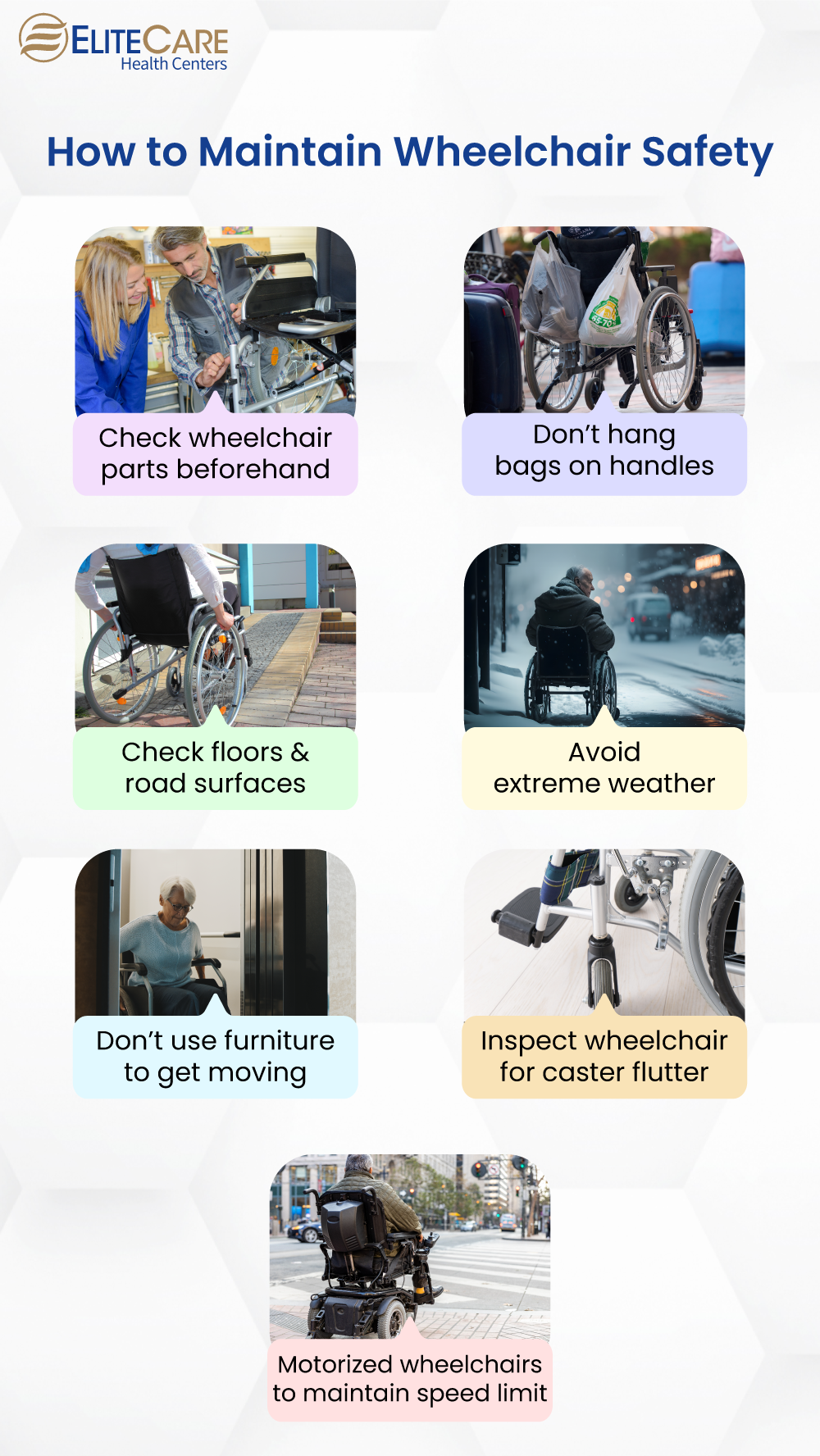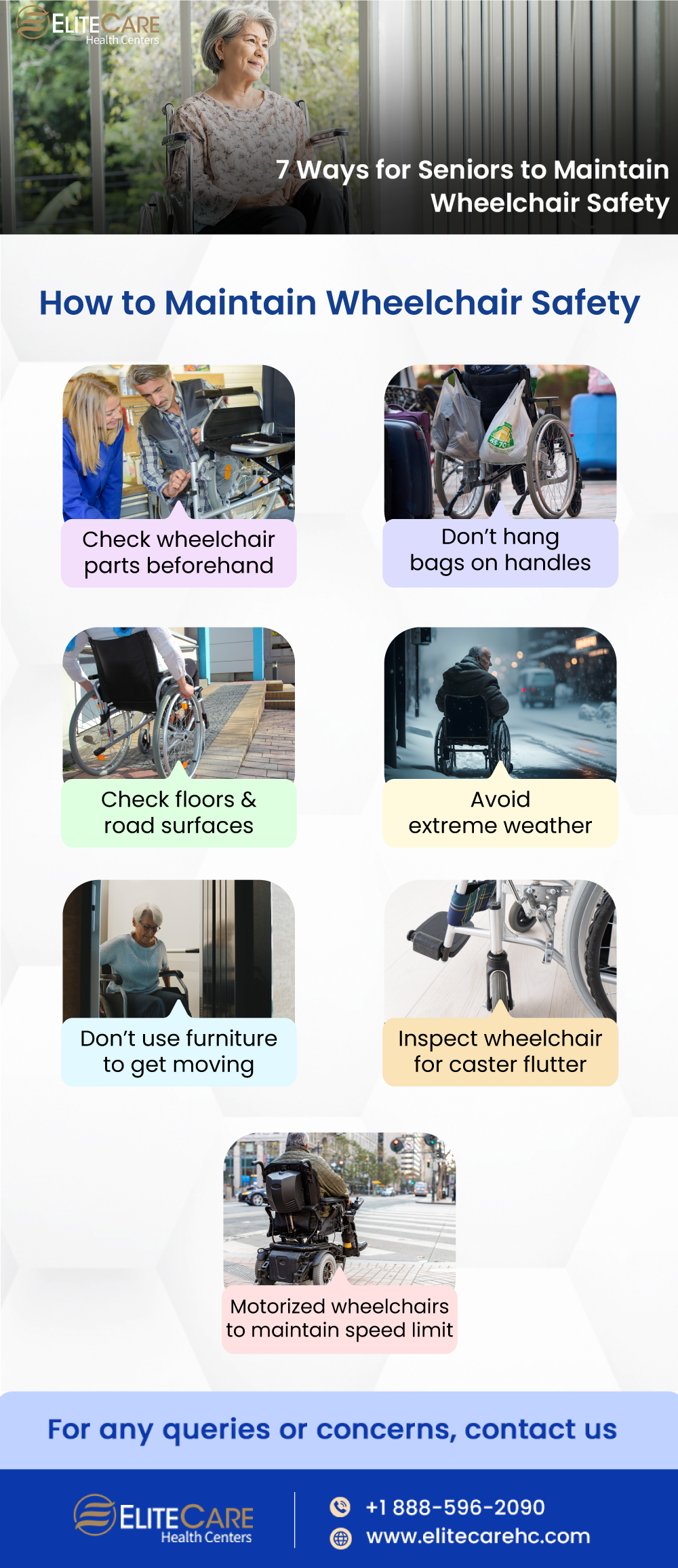
Wheelchairs are essential equipment for seniors who have difficulty walking or standing for long periods of time. They not only increase mobility but also ensure that seniors have greater access to public spaces and buildings. However, according to researchers*, more than half of all wheelchair users experience an accident within three years of use due to falls. Therefore, it is critical to ensure proper wheelchair safety measures.
What is the best wheelchair for seniors and how can they ensure optimum safety? Read on to learn more.
Manual Wheelchair vs. Electric Wheelchair- Which One to Choose?
There are primarily two wheelchair options for seniors: manual and electric. While a manual wheelchair only moves with physical effort, an electric one works on motor power. Manual wheelchairs require physical strength to move around, which can be specifically challenging for seniors with impaired upper-body mobility. But at the same time, they are cost-effective, have low maintenance costs, and are easy to transport.
In contrast, an electric wheelchair is a better option as it doesn’t require almost any exertion on the user’s part. Also, the design of the electric wheelchair ensures long-term use. However, these wheelchairs are expensive, bulky, and come with additional parts which can be difficult to replace or transport.
It is crucial to understand seniors’ medical issues and health conditions before selecting any type of wheelchair for them. Caregivers can also consult a primary care physician if required.
How to Maintain Wheelchair Safety

1. Check the parts beforehand
Seniors or their caregivers need to check the wheels and tires before using them. Inspect the wheels and tires regularly to ensure they are properly inflated and in good condition. Make sure the tires have sufficient tread and that there are no cracks or punctures.
In addition, check the brakes regularly to ensure they are working properly, and adjust the brake tension as required to ensure they hold the wheel.
2. Take a note of the terrain
Different surfaces can impact the wheelchair’s mobility, and seniors or their caregivers should assess the wheelchair’s ability beforehand to navigate safely. Uneven surfaces, inclines, declines, and curbs can cause the wheelchair to tip over or become unstable. Before proceeding, seniors should assess the terrain and ask for assistance if necessary.
3. Keep bags off the handles
It may be tempting to hang bags or other items off the handles of the wheelchair for convenience. However, this can impact the balance of the wheelchair and cause it to tip over. Instead, seniors should use a backpack or secure the bags to the back of the wheelchair.
4. Check weather conditions
Weather conditions can impact the safety of wheelchair use. Rain or snow can make surfaces slippery, and high winds can make it difficult to maintain control of the wheelchair. Seniors should check the weather forecast before venturing outside and adjust their plans accordingly.
5. Don't push off furniture to move faster
Some seniors may be tempted to push off furniture or walls to move faster in their wheelchairs. However, it can cause damage to the wheelchair or furniture and may result in injury. Seniors should use the wheelchair’s footrests or push rims to move safely.
6. Be aware of caster flutter
Sometimes, when the small wheels at the front of the wheelchair (known as casters) are not properly aligned, they may wobble or oscillate at high speeds. This is known as caster flutter and it can cause the wheelchair to veer sideways or even tip over.
Caster flutter is particularly dangerous for users of electric wheelchairs, as the wheelchair becomes difficult to control manually during caster flutter. Seniors should seek out a professional inspection if they suspect caster flutter.
7. Follow the speed limit
Electric wheelchairs can travel up to 8 mph, but this speed may not always be safe for seniors. For example, in crowded or busy areas, it may be safer to slow down or come to a complete stop. Additionally, seniors should be aware of any signs or warnings indicating a speed limit in certain areas, such as parks or sidewalks. They should follow the speed limit recommended by the manufacturer or a healthcare center.
Is Wheelchair Cost Covered under Medicare or Medicaid?
Wheelchair costs may be covered under Medicare or Medicaid, but the coverage depends on several factors, such as the type of wheelchair, the reason for needing it, and the individual’s specific insurance plan.
For Medicare, a primary care physician must prescribe the wheelchair, and the individual must meet certain eligibility criteria. Medicare Part B covers 80% of the cost of a manual or power wheelchair, while the remaining 20% is usually covered by a Medicare supplement insurance plan or out-of-pocket.
For Medicaid, coverage may vary by state, but in general, Medicaid may cover the cost of a wheelchair if it is medically necessary and prescribed by a doctor. Medicaid may also cover the cost of repairs and replacements.
There may be certain restrictions or limitations on coverage, and individuals should check with their insurance provider or consult a senior care service for more information on their specific coverage. Additionally, some individuals may be eligible for financial assistance through non-profit organizations or government programs to help cover the cost of a wheelchair.
Conclusion
Maintaining wheelchair safety is essential for seniors who rely on it for mobility and day-to-day activity. Regular inspections and maintenance can help prevent accidents and injuries, which can greatly improve the quality of life for seniors. By following the suggestions outlined in this blog, seniors and their caregivers can ensure that their wheelchairs are safe, functional, and comfortable to use. It is important to visit a medical clinic that offers senior care services and consult primary care physicians and take their recommendations into consideration while choosing a wheelchair for seniors. Contact EliteCare Health Centers, one of the best healthcare centers in Florida and schedule an appointment with our board-certified primary care physicians for detailed guidance.
*Chen, W., Jang, Y., Wang, J., Huang, W. C., Ip, W., Mao, H., & Wang, Y. F. (2011). Wheelchair-Related Accidents: Relationship With Wheelchair-Using Behavior in Active Community Wheelchair Users. Archives of Physical Medicine and Rehabilitation, 92(6), 892–898. https://doi.org/10.1016/j.apmr.2011.01.008






